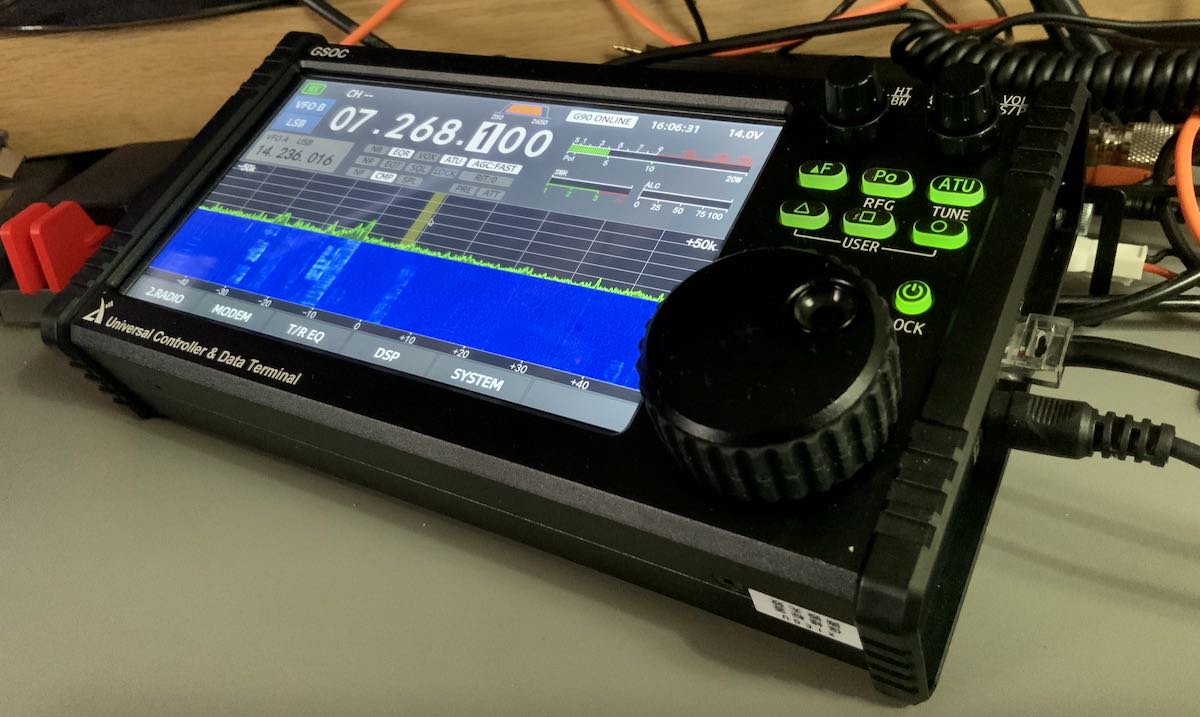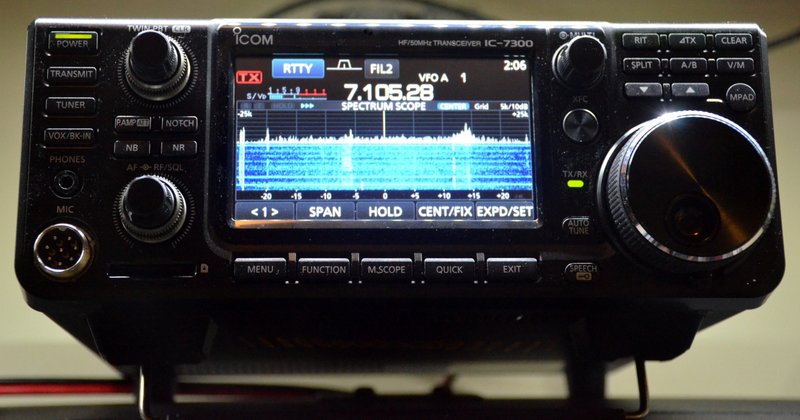 I was recently asked to make a table comparing the basic features and specifications of the new Xiegu GSOC/G90 combo, and comparing it with the Icom IC-7300 and IC-705.
I was recently asked to make a table comparing the basic features and specifications of the new Xiegu GSOC/G90 combo, and comparing it with the Icom IC-7300 and IC-705.
This is by no means a comprehensive list, and I plan to add to it as I test the GSOC. It doesn’t include some of the digital mode encoding/decoding features yet. I’m currently waiting for the next GSOC firmware upgrade (scheduled for November 20, 2020) before I proceed as it should add mode decoding, audio recording, fix CW mode latency, and add/fix a number of other items/issues.
Comparison table
Quick summary of comparison
At the end of the day, these radios are quite different from each other. Here’s a quick list of obvious pros and cons with this comparison in mind:
Xiegu GSOC G90 combo ($975 US)
Pros:
- The GSOC’s 7″ capacitive touch screen is the biggest of the bunch
- The GSOC can be paired with the G90 or X5101 transceivers (see cons)
- The GSOC controller is connected to the transceiver body via a cable, thus giving more options to mount/display in the shack
- The G90 transceiver (read review) is a good value and solid basic transceiver
- Upgradability over time (pro) though incomplete at time of posting (con)
- GSOC can be detached, left at home, and G90 control head replaced on G90 body to keep field kit more simple (see con)
Cons:
- The GSCO is not stand-alone and must be paired with a Xiegu transceiver like the Xiegu G90 or X5105. The X5105 currently has has limited functionality with the GSOC but I understand this is being addressed. (see pro)
- I don’t believe the GSOC can act as a sound card interface if directly connected with a computer (I will correct this if I discover otherwise). This means, for digital modes, you may still require an external sound card interface
- No six meter coverage like the IC-7300 and IC-705
- Quite a lot of needed cables and connections if operating multiple modes; both GSOC and G90 require separate power connections
- At time of posting, a number of announced features missing in early units, but this should be addressed with a Nov 20, 2020 firmware upgrade
- Replacing and removing G90 control head requires replacing four screws to hold in side panels and secure head to transceiver body (see pro)
Icom IC-7300 ($1040 US)
Pros:
- Built-in sound card interface for for easy digital mode operation
- Excellent receiver specifications (click here to view via Rob Sherwood’s table)
- Possibly the most popular transceiver Icom has ever made (thus a massive user base)
- Well thought-through ergonomics
- Includes six meter operation and expanded RX frequencies (compared with G90/GSOC); high frequency stability
Cons:
- The heaviest of this group (con), but it is a 100 watt transceiver (pro)
- Smaller display than the GSOC
- Touch sensitive display (not capacitive like the GSOC)
- Faceplate not detachable like the G90
Icom IC-705 ($1300 US)
Pros:
- Built-in sound card interface for for easy digital mode operation
- Excellent receiver specifications (click here to view via Rob Sherwood’s table)
- Can use swappable Icom HT battery packs
- Well thought-through ergonomics, but on that of the IC-7300
- Includes six meters and VHF/UHF multi-mode operation with high frequency stability
- Includes D-Star mode
- Includes wireless LAN, Bluetooth, and built-in GPS
- Weighs 2.4 lbs/1.1 kg (lightest and most portable of the bunch)
Cons:
- No internal ATU option
- Maximum of 10 watts of output power
- The priciest of this bunch at $1300 US
In short, I’d advise those looking for a 100 watt radio, to grab the Icom IC-7300 without hesitation. It’s a solid choice.
If you’re looking for the most portable of these options, are okay with 10 watts of maximum output power, and don’t mind dropping $1300 on a transceiver, the Icom IC-705 is for you. You might also consider the Elecraft KX3, Elecraft KX2, and lab599 Discovery TX-500 as field-portable radios. None of them, however, sport the IC-705 display, nor do they have native VHF/UHF multimode operation (although there is a limited KX3 2M option). The IC-705 is the only HF QRP radio at present that also has LAN, Bluetooth, and built-in GPS. And, oh yes, even D-star.
If you’re a fan of the Xiegu G90 or already own one, give the GSOC controller some consideration. It offers a more “modular” package than any of the transceivers mentioned above in that the controller and G90 faceplace can be swapped on the G90 body. The GSOC screen is also a pleasure since there are two USB ports that can connect a mouse and keyboard (driver for mine were instantly recognized by the OS). The GSOC/G90 combo is a bit “awkward” in that a number of cables and connections are needed when configured to operate both SSB and CW: a CW key cable, Microphone cable, I/Q cable, serial control cable, power cable for the GSOC, and a power cable for the G90. This doesn’t include the cables that might be needed for digital operation. I dislike the fact that the CW cable can only be plugged into the transceiver body instead of the GSOC controller like the microphone. Still: this controller adds functionality to the G90 (including FM mode eventually) that may be worth the investment for some.
Did I miss something?
I’ll update this list with any obvious pros/cons I may have missed–please feel free to comment if you see a glaring omission! Again, these notes are made with a comparison of these three models in mind, not a comprehensive review of each. I hope this might help others make a purchase decision.








In our country (New Zealand) ICOM is the only game in town so to speak since no repair facilties are available for the Xiegu. On eHam there is also a post of a nearby HAM firing up his 100 Watt transceiver and frying the front end of the Xiegu turning it into a paperweight.
Thank you. I was hoping to use Linux on a Raspberry pi with the wifi Hotspot the new firmware update allows. There is at least one ham that wrote a Linux program to do some control of the 705. On a couple channels they have directions for how to achieve digital modes with windows 10 and no wires .
Thanks hope you enjoy your radio
Looking at a 705 for portable (sota looks good) digital modes. Will 705 work with a raspberry pi running Linux without all the wires?
Hi, Art,
The only wire I believe you would need would be the micro USB cable that connects to the IC-705. When I use my Surface Go tablet with the IC-705, that’s the only cable I need. The IC-705 has a built-in soundcard and the computer recognizes it as such.
Cheers,
Thomas
It tends to get overlooked due to newer models, but the Icom IC-7100 still is available as well.
Remote head, touchscreen, IF DSP, HF+6m+2m+440, D-Star, 100w HF, etc.
Currently around $750 shipped after rebate.
I personally do not see the value added to a G90 at the current GSOC price of over $500. At a price of $200 or so maybe. But even then only if the GSOC firmware updates promised actually are provided and they work. Xiegu’s firmware history does not bode well for this!. A small laptop or even a Windows tablet can do much of what the GSOC can do while using the familiar apps such as WSJT-X, JS8Call, ftdigi, HDSDR, SDR#, etc. If Xiegu follows through on their plans for the GSOC and prices it more commensurate with its value, then this comparison may be more useful. Also, the above comparison does not touch on the actual functions such as filters, DSP, and many more that IC7300 and IC705 provide that the G90 & GSOC combo fail to be in the same league.
Hello,
with CW in my mind I wanted to replace a former Kx3/Px3 – Combo.
But the relays on the Icom were rattling like a sewing machine and the G90 had nearly no QSK above 20 wpm : also a No-Go without CW-messages.
What about the CW capabilties of the Yaesu?
So no Kx3/PX3 replacemant inside – Elecraft unbeatable concerning CW-Operation?
I switched in the meantime back to a 20 year old K2 and am happy.
73 de Hajo
Uuups,
I mixed things up … There is no Yaesu at least not now.
Sorry for the bandwidth.
Related question: will the Icom AH-4 antenna tuner work well with the IC-705?
What are good choices for ATU and 100W amplifier for the IC-705?
Hi, Paul: So my answer to this got a bit wordy, so I turned it into a post: https://swling.com/blog/2020/11/portable-tuner-atu-options-for-the-new-icom-ic-705/
Cheers,
Thomas